Bayesian Estimation of Different Scale Parameters Using a LINEX Loss Function
Abstract
The LINEX loss function, which climbs exponentially with one-half of zero and virtually linearly on either side of zero, is employed to analyze parameter analysis and prediction problems. It can be used to solve both underestimation and overestimation issues. This paper explained the Bayesian estimation of mean, Gamma distribution, and Poisson process. First, an improved estimator for μ2 is provided (which employs a variation coefficient). Under the LINEX loss function, a better estimator for the square root of the median is also derived, and an enhanced estimation for the average mean in such a negatively exponential function. Second, giving a gamma distribution as a prior and a likelihood function as posterior yields a gamma distribution. The LINEX method can be used to estimate an estimator using posterior distribution. After obtaining , the hazard function and the function of survival estimators are used. Third, the challenge of sequentially predicting the intensity variable of a uniform Poisson process with a linear exponentially (LINEX) loss function and a constant cost of production time is investigated using a Bayesian model. The APO rule is offered as an approximation pointwise optimal rule. LINEX is the loss function used. A variety of prior distributions have already been studied, and Bayesian estimation methods have been evaluated against squared error loss function estimation methods. Finally, compare the results of Maximum Likelihood Estimation (MLE) and LINEX estimation to determine which technique is appropriate for such information by identifying the lowest Mean Square Error (MSE). The displaced estimation method under the LINEX loss function was also examined in this research, and an improved estimation was proposed.
1. Introduction
The LINEX loss function is a nonlinear function that climbs exponentially with one end of 0 and virtually exponentially on another [1]. For values approaching zero, this error function reduces to squared error loss. For calculating the binomial variable, the LINEX loss function is used. This loss function was used to estimate the median of a normally distributed [2]. Consider the prediction error in the perspective of exponential distribution reliability analysis. Then, using the LINEX loss function, Bayesian mean and square mean estimations of a normally distributed were investigated. Under the LINEX loss function, the MMSE criterion is unacceptable. The uniformly minimum risk unbiased (UMRU) estimator under the LINEX loss function can be found using information and facts if there is underestimation and overestimation in real-life situations [3]. The exponential distribution is a well-known distribution that may be used in a variety of fields, including science, economy, and demographics [4]. It is a well-known one-parameter distribution that is frequently utilized in model studies [5].
The task of establishing appropriate halting rules is frequently and analytically intractable. Because determining explicit optimum ending times is challenging, numerous approaches were proposed to obtain “asymptotically” optimal regulations [9]. For example, it offered simple but appealing large enough sample approximations to optimal timings, dubbed asymptotically pointwise optimal (APO) rules, and demonstrated that APO rules were asymptotically optimal (AO) under a second scenario. Many publications have examined the APO rule and how it might be used to address those other challenges [10]. Discrete-time events are the focus of the studies in these publications. They discussed how the LINEX error function operated, but still, no specifics or practical solutions were provided on how the LINEX loss function changes the shape variable and error value [11]. Considering the LINEX loss method’s versatility in estimating a location parameter, it does not seem to be useful for estimating scale variables and other values. For two variables, Bayes and probability estimators are used [12]. Under hazard and survival variables used in experiments and analysis methods, Weibull using unfiltered observations is examined.
In continuous-time processes, the idea of the asymptotic element-wise optimization problem is expanded from discrete-time processes [11]. Additionally, with a squared error loss, the APO procedures for predicting the intensities of a homogeneity Poisson process are AO for random priors and asymptotically nondeficient for conjugation priors [13]. Later, it generalized a conclusion for continuous-time processes and demonstrated that under a linear exponential (LINEX) loss function, the APO rules for such a Poisson distribution are AO for such corresponding priors [14]. The LINEX loss function was officially created, and its properties were investigated further. It is a handy asymmetrical nonlinear function that increases dramatically on one end of zero and gradually on the other [15]. Much research has looked into estimating issues with LINEX loss function [16]. After analyzing the data, it assigns relative weights to each given value. Approximations to Bayesian inference exist, such as the Specific Noninformative Prior [17]. Linear Exponential Loss Function, Lindley Approximation, General Entropy Loss Function, and Squared Error Loss Function are all examples of linear, exponential loss functions.
2. Related Work
The Weibull distribution is commonly used in lifespan data modeling and analysis [14]. The considered wide range of a two-parameter Weibull distribution having given shape is estimated in this study. How to use estimated parameters is discussed. Under the LINEX loss function, the Bayes estimator is produced utilizing Jeffreys’ prior. Using generated data sets, the overall performance of the estimation techniques is calculated in small and large sampling for overestimation and underestimation. It has been discovered that the Bayes estimator performed best in observational studies and then when overstatement is much more important than underestimating.
In technology, science, and other fields, the Weibull distribution has been identified as among the most effective distributions for predicting and evaluating lifetime data [18]. To find the most effective approach for calculating its characteristics, the Bayesian estimate strategy for estimation methods, which competes with other estimation approaches, has suddenly received a lot of attention. For assessing the 2 different Weibull failure time distributions, the achievement of the maximum likelihood method and Bayes estimator using expansions of Jeffreys prior knowledge with three wavelet coefficients, namely, the sequential exponential loss, general electron density loss, and square error linear function. Through a simulation analysis with varied sample sizes, these approaches are evaluated using mean square error. The findings demonstrate that for certain values of extensions of Jeffreys’ prior, the Bayesian estimator utilizing extensions of Jeffreys’ prior with linear exponentially error function has the minimum mean square error and actual bias both for weighting factor and the significant impact.
Dey introduced Bayes’ estimation technique for such an Inverse Rayleigh distribution’s unknown quantity (IRD) [19]. Utilizing noninformative prior, Bayes estimation techniques are derived for symmetrical (squared error (SE) loss) and asymmetrical linear exponential loss functions. The estimators’ system is assessed based on its relative hazard under two wavelet coefficients. They also construct the reliability method’s Bayesian estimation method using symmetrical and asymmetrical loss functions and compare their efficiency that used a Monte Carlo simulation analysis. Lastly, to highlight the findings, a numerical investigation is offered.
Gupta presented a new method for predicting the variable of the Rayleigh distribution, Bayesian and E–Bayesian estimate methods are provided in this study [20]. The parameter’s Bayes estimation is calculated using the LINEX loss function and the concept that the prior probability is relevant, i.e., gamma distribution. Furthermore, a simulation study utilizing MATLAB software was used to compare the E-Bayes estimation method with related Bayes estimators.
The work of Lee and Hwang looks at the challenge of progressively predicting the average of a Poisson process in a Bayesian network using a LINEX (linear exponential) loss function and a fixed price per experience [21]. For arbitrary priors, an approximation pointwise optimum rule with such a distribution function is developed and proven to be exponential optimal. An actual data set is used to demonstrate the suggested monotonically elementwise optimum rule.
3. Proposed Methodology
Let us consider a1, a2, ……an an n-person representative sample from such an average distribution with median μ and variance σ2. Assume that compared to the population median with minimum error , the sample mean (σ2/n) is an adequate and accurate estimator. The standard approach of comparing estimation methods for the significant feature using mean square error (MSE) may not provide a clear favorite for scale parameters [22]. Limiting the class of estimators is one technique to make the task of finding the “best estimator” more tractable. Consider impartial and partially invariant estimation techniques as a popular approach to limiting the category of estimation techniques.
U(a) = θ, R(a) = θ2 and v = 1 in the negative exponential distribution (NED). The scale parameter is θ, and the improved estimator is with an MSE E1 = (θ2/n + 1) lower than (θ2/n). In a normal distribution with mean μ and variance σ2, where σ2 acts as a standard deviation and the maximum likelihood estimate are (MLE), the estimators for σ2 (the unbiased estimator).
Thus, MSE (M2) = (2σ4/n) and then MSE. (M2) = (2σ4/n − 1)
If |x|⟶0, Square inaccuracy is the result of the LINEX loss.
Mean Estimation using a LINEX loss function.
x ≠ 0, and if the bc = x, Later, this procedure would equal y(exΔ − zΔ − 1)
The loss function of LINEX minimizes the squared error if |x|⟶0.
The proposed estimation is with a. MinQ(x, Δ∗) = x − (n + 1)(x − e(−x/n+1))
The values of z can be calculated given the values of n, v ≥ 1 and 0 ≤ x ≤ 0.6. Then, get the lowest risk by plugging the cmin into equation (5) [23]. Figures 1–3 show the relative effectiveness of the estimator E1 in comparison to E′ for v = 2.00(2.25)2.50, x = 0.2(0.4)0.6 and n = 5(5)20. The figure illustrates that if v ≥ 1 is greater than 1, the estimator outperforms with smaller n values and a level up to 2.00.
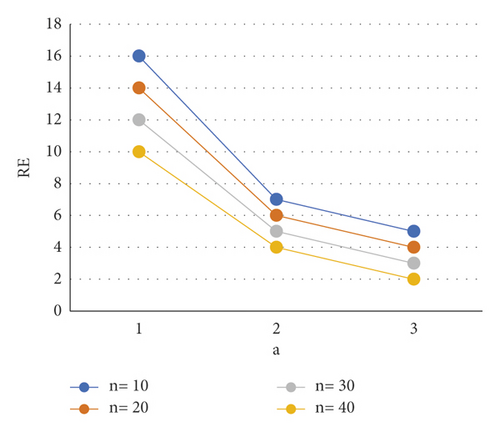
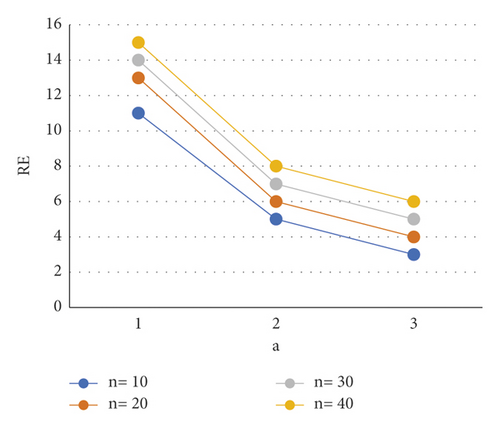
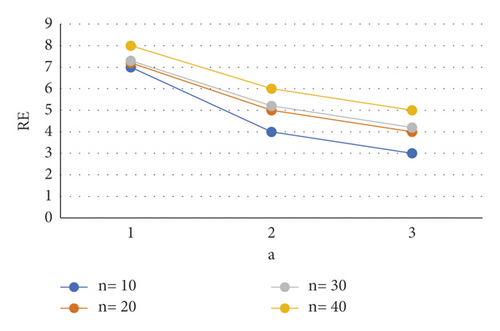
This demonstrates that in the LINEX loss function, adequate statistics x can also be used to determine the UMRU estimation.
3.1. Maximum Likelihood Estimation
and are based on Maximum Probability [2]. The ratio of hazard and survival model is estimated.
3.2. The Poisson Process Rules of APO and AO
This suggests an APO condition in a Poisson distribution as in Section 3.2.
For and Qt(b) = −1.
3.3. The LINEX Loss Function of Bayesian
3.4. Square Estimation of Mean by Using LINEX Loss Function
Mostly in the case of a negative exponential function [29], the enhanced estimator is used.
3.5. Nondeficiency of Asymptotic
For any c > 0, and , it can be seen that c > 0. Theorem 1 states that in the gamma previous also with requirements α > 0, β > 0, and αβ + 1 > 0, the halting rule and the Bayesian sequential method are APO and AO, accordingly (Mahmoudi 2012). In addition, Theorem 2 in this statement demonstrates that the Bayes sequential process is asymptotically quasi in this instance.
Establish several auxiliary results before and use them to establish the major theorem.
4. Numerical Study and Discussion
4.1. Estimation Error LINEX Loss Function
Consider the estimation error as . Figure 4 shows how a negative value of c gives more importance to underestimation, whose quantity describes the level of asymmetry. Figure 5 shows that a positive value of c will not provide an additional load to overestimation, whose quantity represents the extent of asymmetry. The LINEX loss function is essentially symmetric for small values of |z| but not that far from the mean square error loss function in Figure 6. The LINEX loss function is essentially asymmetric for large values of |z| in Figure 7. When the prediction error is in Figure 8, it climbs almost continuously z > 0, and when the prediction error is in Figure 9, it rises practically exponentially.
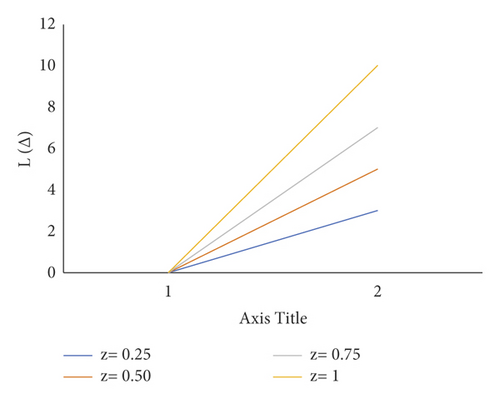
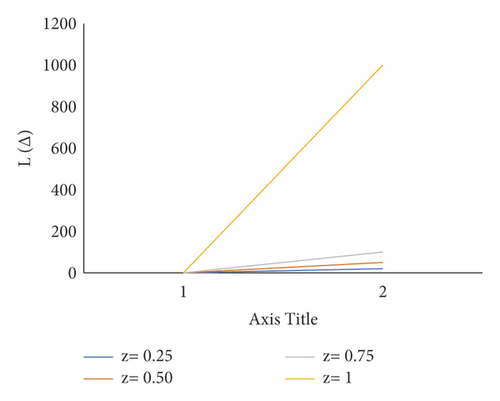
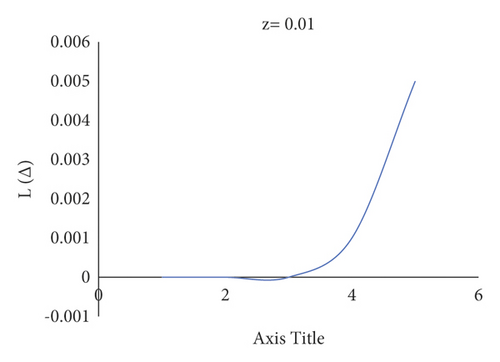
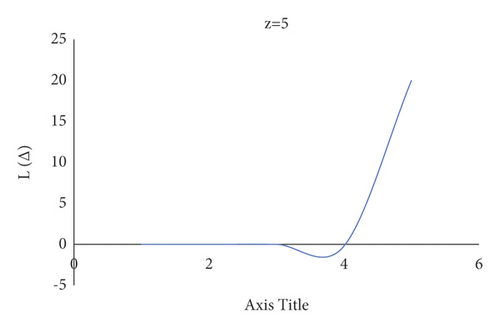

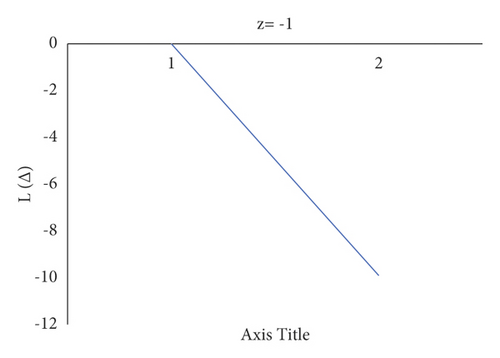
This offers the APO rules and the Bayesian estimate under gamma prior supplied and evaluates the APO rule’s Bayesian hazard to the second element of the Bayesian risk of an optimum halting rule (or APO rule). Let be the estimation for such Bayes risk of the APO rule , and ; that is, the second level of the Bayesian hazard of the optimum halting rule, depending on Theorem 1.
The estimates of the APO principle , the Bayesian estimator , the calculated Bayes risk , the second-order , and the adjusted mean inaccuracy of Bayes risk for various values of x, α, β, and z. Because the requirements are different for a < 0, the variables of () are selected as (1.5, 0.2), (2.5, 0.1), and (2.5, 0.1). of Theorem 1 can be expressed as α > 1 and 0 < β < −1/a. Table 1 shows that when z drops, the estimates increase and and almost decrease. Furthermore, when z gets smaller, the estimations of absolute errors of Bayesian hazard Δz approach to zero.
| (α,β) = (2.5, 0.4) | (α,β) = (3.5, 0.2) | |||||||||
|---|---|---|---|---|---|---|---|---|---|---|
| z | Δz | Δz | ||||||||
| 10 | 0.4324 | 0.2347 | 0.7632 | 0.7352 | −0.4567 | 0.0876 | 0.5293 | 0.2734 | −3.8752 | −1.3747 |
| 0.01 | 1.2346 | 0.2765 | 0.2763 | 0.3678 | −0.3456 | 0.7653 | 0.2636 | 0.2863 | −0.1254 | −2.3752 |
| 0.05 | 1.2487 | 0.3248 | 0.6427 | 0.9782 | −0.3657 | 1.4321 | 0.3826 | 0.2737 | 0.0274 | 2.7358 |
| 0.001 | 2.4567 | 0.2654 | 0.2753 | 0.7643 | 0.1236 | 8.6537 | 0.3362 | 0.3823 | 0.2735 | 0.2837 |
| 0.005 | 10.9876 | 0.3875 | 0.3875 | 0.8752 | 0.1432 | 11.7526 | 0.2763 | 0.2836 | 0.2934 | 0.2863 |
| 0.0001 | 13.9769 | 0.2873 | 0.2643 | 0.9826 | 0.0123 | 23.9875 | 0.3826 | 0.2733 | 0.2647 | 0.3754 |
| 0.0005 | 23.8765 | 0.3864 | 0.3625 | 0.2764 | −0.0154 | 35.7521 | 0.2863 | 0.3826 | 0.2735 | 0.2647 |
The survival likelihood of patients after therapy using the MLE and Bayesian LINEX Loss functions: Both findings show that the estimated value is bigger than that of the real value, but the Bayesian LINEX estimated value is closer to a survival value than that of the MLEs. The outcome reveals that all variables are inversely proportional to time. Patients’ chances of survival are decreasing and converging to zero in less than three years. It signifies that the treatment’s effects will fade with time. In around 10 days of varying ranges, the decreasing level of survival chance is around 10%. The survival report’s hazard function is linked to the degeneration rate. Table 2 shows the hazard values estimation using both the MLE and Bayesian LINEX Loss functions.
| Hazard | Hazard value estimation using MLE | Hazard value estimation using Bayesian LINEX |
|---|---|---|
| 0.008231808 | 0.0075643263 | 0.0076543276 |
The hazard value is used to calculate the dependability rate of failure. The rate of failure of the true value utilizing MLE and Bayesian LINEX is 0.8231808%, 0.7564323%, and 0.76543276%, respectively, according to Table 2. It means that the Bayesian estimate is closer to the real number than that of the MLE estimate. By looking at the lowest MSE of both outcomes, one technique to discover the optimal method would be to calculate Mean Squared Error (MSE). Table 3 depicts them.
| Mean square error | Survival | Hazard |
|---|---|---|
| Bayesian LINEX loss function | 2.7872E − 08 | 0.000303142 |
| MLE | 2.91727E − 06 | 0.000245904 |
The Value of MSE of Hazard and survival with Bayes LINEX Loss Function would be less than MSE values of hazard and survival over MLE, as shown in Figures 10 and 11.
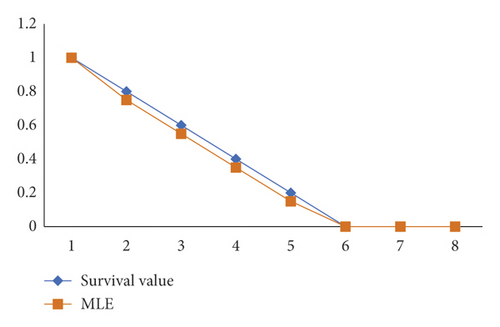
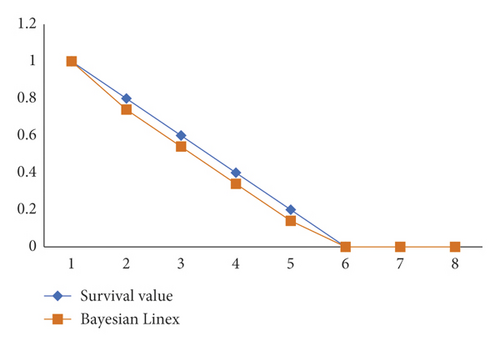
Although both graphs 1 and 2 indicate a varying value well with the actual cost of survival chances, graph 2’s curve does have a faster distance between an actual and Bayesian value.
5. Conclusion
The LINEX loss function, when using comparative estimation error, gives preference to overestimation in displaying that the allocation is irregular for negative numbers of the scaling factor, while it also gives weight to overestimation in displaying that the transfer is asymmetric for positive values. It lends more importance towards overestimation, which indicates the degree of imbalance, for positive attributes of c. The criterion of the LINEX loss function is achieved for positive attributes of the scaling factor. However, this is more widely disseminated than the initial random sample. In this example, it is also clear that prediction error, rather than estimation of comparative error, performs better when the LINEX loss function is used. As a result, if the LINEX loss function performs better, the estimated error should be utilized rather than the estimation of relative error. Second, the rate of hazard and period of article observation plays an important influence in determining survival value. These are approximately equal to the chances of survival. Finally, the MSE demonstrates that the Bayes LINEX Loss function outperforms the MLE. For future studies, the derivation of the posterior distribution for the distribution estimation under squared error could be explained using informative and noninformative priors.
Conflicts of Interest
The authors declare that there are no conflicts of interest regarding the publication of this paper.
Acknowledgments
This paper was supported by the Taif University Researchers Supporting Project number (TURSP-2020/20), Taif University, Taif, Saudi Arabia.
Open Research
Data Availability
Data are available from the corresponding author upon request.




